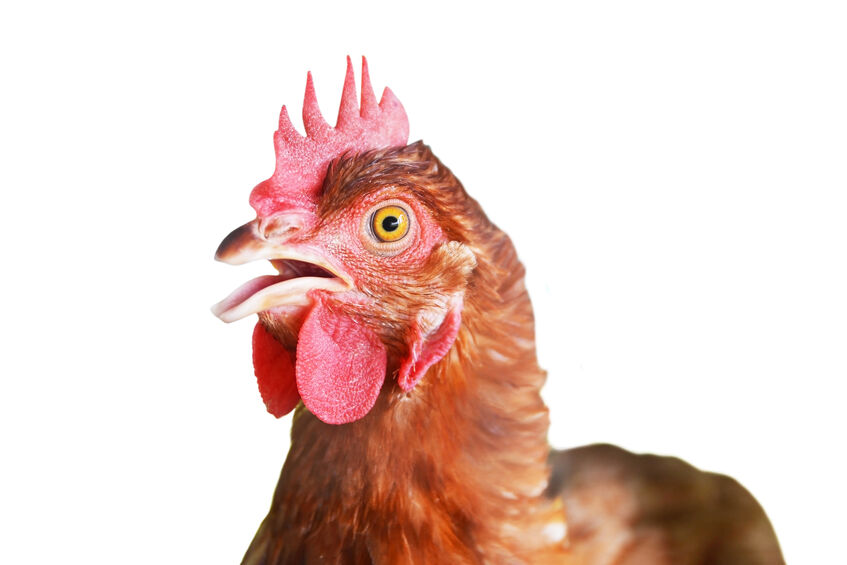
Blindness is not a common condition among chickens. But when it does occur, it can be disconcerting for both the chicken and the human handler. Aside from injury resulting from a poke in the eye, here are three main reasons why a chicken goes blind.
Marek’s Disease
Marek’s disease is a cancer in chickens caused by a herpesvirus. This virus can, among other conditions, cause blindness in one eye or both.
Marek’s disease is extremely common. But infected chickens don’t necessarily go blind or show any other signs of infection. Blindness and other signs, however, may develop as a chicken ages.
Marek’s disease has no known treatment. A vaccine is available that does not prevent chickens from becoming infected or spreading the virus. But it does prevent the virus from causing tumors. And it reduces shedding of the virus by infected birds.
Ammonia Burn
Ammonia is a pungent smelling gas created by bacteria in unsanitary, damp litter. When ammonia in the coop occurs in high concentrations, it dissolves in a chicken’s tears, producing ammonium hydroxide. This irritating alkali causes ammonia burn.
A fancy name for ammonia burn is keratoconjunctivitis. It’s a double-whammy eye inflammation in which the chicken has both keratitis and conjunctivitis at the same time.
Keratitis is inflammation of the cornea. Conjunctivitis is inflammation of the conjunctiva, the thin membrane of the inner eyelid and the inner corner of the eye’s surface. A common name for conjunctivitis is pink eye, which typically affects both eyes.
Initial signs include reddened eyelids and watery eyes that gradually become filled with solidified puss. Other signs may include facial swelling and sensitivity to light. An affected chicken may rub its head against a wing. Long term exposure can cause scarring that results in lopsided or almond-shape eyes and eventual blindness.
Treatment involves controlling ammonia in the coop and improving ventilation. Assuming ammonia burn has not developed far enough to damage the cornea, chickens may take one month or even more to recover. A good eye ointment, such as Systane, can be helpful. So can a vitamin A supplement.
Vitamin A Deficiency
Vitamin A is a group of related nutrients required for vision, growth, and bone development. Deficiency can occur in chickens that are fed stale commercial rations or an improperly balanced home-mixed ration. It may also be caused by any health condition that interferes with nutrient absorption, such as coccidiosis or worms.
A hen that’s deficient in vitamin A will lay fewer eggs. And the eggs are likely to include blood spots. She will develop watery eyes and a runny nose. Eventually a milky white cheesy material will accumulate in her eyes, causing them to stick together. Left untreated, the chicken will go blind.
A good source of vitamin A is a vitamin AD&E supplement, used as directed on the label. Another good source is cod liver oil mixed into the ration at the rate of 2 tablespoons per 5 pounds. Vitamin A absorbs rapidly, so an affected chicken that’s not too far along should respond fairly soon
Go easy on any vitamin A supplement, since an excessive amount is toxic to chickens. Ironically, the signs of vitamin A excess are similar those of deficiency. By far the best way to ensure your chickens get enough vitamin A to maintain good eyesight is to provide them with access to green forage.
How to Tell a Chicken Is Blind
A blind eye usually takes on a smoky, gray look, and the pupil becomes irregular in shape. When only one eye is blind, the pupils are usually unequal in size.
If you slowly move a finger toward the affected eye, a blind chicken won’t blink or dodge your hand, as would a bird that can see. Don’t wave your hand, though, because the chicken may feel the stirred air and blink or move its head even if it can’t see.
A chicken usually does relatively well despite being blind. The blind chicken needs feed and water readily available. It also needs companion chickens and confinement to a limited area where it won’t get lost or be vulnerable to predation. But even when a partially or fully blind chicken appears to be doing well, keep a close watch to make sure the bird eats enough to maintain its normal weight.
And that’s today’s news from the Cackle Coop.
Gail Damerow is author of The Chicken Health Handbook.

